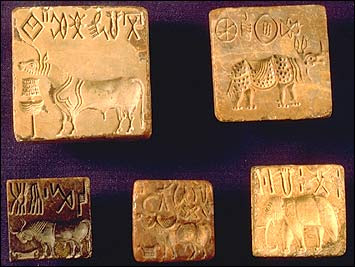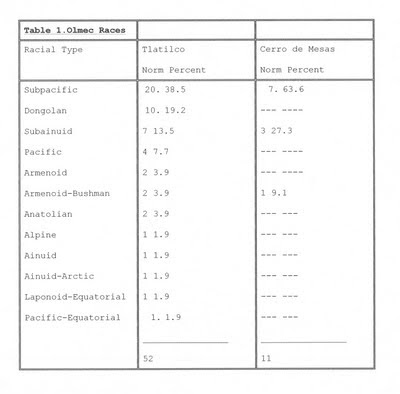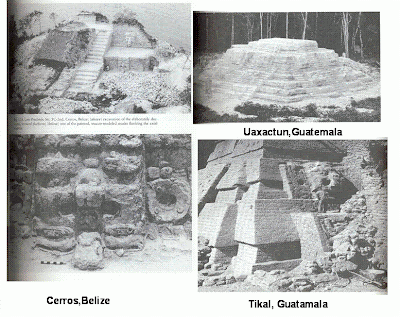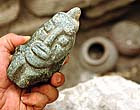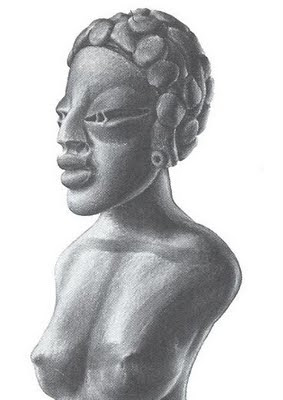Afrocentrism, is a mature social science that was founded by Afro-Americans almost 200 years ago.
These men and women provided scholarship based on contemporary archaeological and historical research the African/Black origination of civilization throughout the world. These Afro-American scholars, mostly trained at Harvard University (one of the few Universities that admitted Blacks in the 19th Century) provide the scientific basis for Afrocantrism and the global role played by African people in civilizing the world.
Afrocentrism and the africalogical study of ancient Black civilizations was began by Afro-Americans.
 Edward Blyden
Edward BlydenThe foundation of any mature science is its articulation in an authoritive text (Kuhn, 1996, 136). The africalogical textbooks published by Hopkins (1905), Perry (1893) and Williams (1883) provided the vocabulary themes for further afrocentric social science research.

The pedagogy for ancient africalogical research was well established by the end of the 19th century by African American researchers well versed in the classical languages and knowledge of Greek and Latin. Cornish and Russwurm (1827) in the Freedom Journal, were the first African Americans to discuss and explain the "Ancient Model" of history.
These afrocentric social scientists used the classics to prove that the Blacks founded civilization in Egypt, Ethiopia, Babylon and Ninevah. Cornish and Russwurm (1827) made it clear that archaeological research supported the classical, or "Ancient Model" of history.
Edward Blyden (1869) also used classical sources to discuss the ancient history of African people. In his work he not only discussed the evidence for Blacks in West Asia and Egypt, he also discussed the role of Blacks in ancient America (Blyden, 1869, 78).
By 1883, africalogical researchers began to publish book on African American history. G.W. Williams (1883) wrote the first textbook on African American history. In the History of the Negro Race in America, Dr. Williams provided the schema for all future africalogical history text.

Dr. Williams (1883) confirmed the classical traditions for Blacks founding civilization in both Africa (Egypt, Ethiopia) and West Asia. In addition, to confirming the "Ancient Model" of history, Dr. Williams (1883) also mentioned the presence of Blacks in Indo-China and the Malay Peninsula. Dr. Williams was trained at Howard.
A decade later R.L. Perry (1893) also presented evidence to confirm the classical traditions of Blacks founding Egypt, Greece and the Mesopotamian civilization.

He also provided empirical evidence for the role of Blacks in Phoenicia, thus increasing the scope of the ASAH paradigms.
Pauline E. Hopkins (1905) added further articulation of the ASAH paradigms of the application of these paradigms in understanding the role of Blacks in West Asia and Africa.
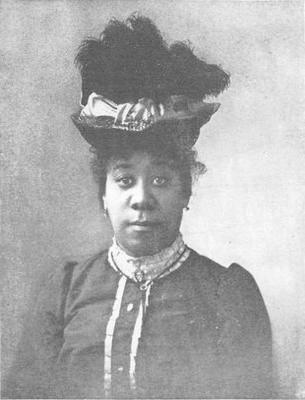
Hopkins (1905) provided further confirmation of the role of Blacks in Southeast Asia, and expanded the scope of africalogical research to China (1905).
This review of the 19th century africalogical social scientific research indicate confirmation of the "Ancient Model" for the early history of Blacks. We also see a movement away from self-published africalogical research, and publication of research, and the publication of research articles on afrocentric themes, to the publication of textbooks.
It was in these books that the paradigms associated with the "Ancient Model" and ASAH were confirmed, and given reliability by empirical research. It was these texts which provided the pedagogic vehicles for the perpetuation of the africalogical normal social science.
The afrocentric textbooks of Hopkins (1905), Perry (1893) and Williams (1883) proved the reliability and validity of the ASAH paradigms. The discussion in these text of contemporary scientific research findings proving the existence of ancient civilizations in Egypt, Nubia-Sudan (Kush), Mesopotamia, Palestine and North Africa lent congruency to the classical literature which pointed to the existence of these civilizations and these African origins ( i.e., the children of Ham= Khem =Kush?).
The authors of the africalogical textbooks reported the latest archaeological and anthropological findings. The archaeological findings reported in these textbooks added precision to their analysis of the classical and Old Testament literature. This along with the discovery of artifacts on the ancient sites depicting Black\African people proved that the classical and Old Testament literature, as opposed to the "Aryan Model", objectively identified the Black\African role in ancient history. And finally, these textbooks confirmed that any examination of references in the classical literature to Blacks in Egypt, Kush, Mesopotamia and Greece\Crete exhibited constancy to the evidence recovered from archaeological excavations in the Middle East and the Aegean. They in turn disconfirmed the "Aryan Model", which proved to be a falsification of the authentic history of Blacks in early times.
The creation of africalogical textbooks provided us with a number of facts revealing the nature of the afrocentric ancient history paradigms. They include a discussion of:
1) the artifacts depicting Blacks found at ancient sites
recovered through archaeological excavation;
2) the confirmation of the validity of the classical and Old
Testament references to Blacks as founders of civilization in Africa and Asia;
3) the presence of isolated pockets of Blacks existing outside Africa; and
4) that the contemporary Arab people in modern Egypt are not the descendants of the ancient Egyptians.
The early africalogical textbooks also outlined the africalogical themes research should endeavor to study. A result, of the data collected by the africalogical ancient history research pioneers led to the development of three facts by the end of the 19th century, which needed to be solved by the afrocentric paradigms:
(1) What is the exact relationship of ancient Egypt, to Blacks in other parts of Africa;
(2) How and when did Blacks settle America, Asia and Europe;
(3) What are the contributions of the Blacks to the rise, and cultural expression ancient Black\African civilizations;
(4) Did Africans settle parts of America in ancient times.
As you can see the structure of Afrocentrism were made long before Boas and the beginning of the 20th Century.In fact , I would not be surprised if Boas learned what he talked about from the early Afrocentric researchers discussed in this post.
As you can see Afro-Americans have be writing about the Global history of ancient Black civilizations for almost 200 years. It was Afro-Americans who first mentioned the African civilizations of West Africa and the Black roots of Egypt. These Afro-Americans made Africa a historical part of the world.
Afro-American scholars not only highlighted African history they also discussed the African/Black civilizations developed by African people outside Africa over a hundred years before Bernal and Boas.
Your history of what you call "negrocentric" or Black Studies is all wrong. It was DuBois who founded Black/Negro Studies, especially Afro-American studies given his work on the slave trade and sociological and historical studies of Afro-Americans. He mentions in the World and Africa about the Jews and other Europeans who were attempting to take over the field.
 Hansberry
HansberryThere is no one who can deny the fact that Leo Hansberry founded African studies in the U.S., not the Jews.Hansberry was a professor at Howard University.
Moreover, Bernal did not initiate any second wave of "negro/Blackcentric" study for ancient Egyptian civilization. Credit for this social science push is none other than Chiek Diop, who makes it clear that he was influenced by DuBois.
 DuBois
DuBoisThese scholars recognized that the people of Southeast Asia and Indo-China were dark skined, some darker than African and Afro-American people. But when they discussed Blacks in Asia they were talking about people of African descent.
In conclusion, Afrocentrism is a mature social science. A social science firmly rooted in the scholarship of Afro-American researchers lasting almost 200 years. Researchers like Marc Washington, Clyde Winters and Mike are continuing a tradition of scholarship began 20 decades ago. All these contemporary researchers is doing is confirming research , that has not been disconfirmed over the past 200 years.
Aluta continua.....The struggle continues.....
REFERENCES
Anselin, A. (1982). Le mythe d' Europe. Paris: Editions Anthropos.
_______.(1982b). "Zeus, Ethiopien Minos Tamoul", Carbet Revue
Martinique de Sciences Humaines,no. 2:31-50.
_______.(1989). "Le Lecon Dravidienne",Carbet Revue Martinique
de Sciences Humaines, no.9:7-58.
Asante,M.A. (July-August, 1996). "Ancient Truths", Emerge , 66-70.
Asante,M.K. (1990) Kemet,Afrocentricity,and Knowledge. Trenton
,NJ:Africa World Press.
_________ (1991). "The Afrocentric idea in Education",Journal
of Negro Education,60(2):170-180.
__________.(December 1991/January 1992). "Afrocentric Curri-
culum".Educational Leadership, pp.28-31.
Bernal, M. (1996, Spring). The Afrocentric interpretation of history: Bernal replies to Lefkowitz. Journal of Blacks in Higher Education, 86-95.
Bernal,M. (1987). Black Athena. New York: Free Association Press. Volume 1.
________. (1991). Black Athena. New York: Free Association Press. Volume 2.
Blyden, E.W. ( January, 1869). The Negro in ancient history.
Methodist Quarterly Review, 71-93.
Blyden, E.W. (1887). Christianity, Islam and the Negro Race. Edinburgh: Edinburgh University Press.
_____________. (1890). The African Problem and the method for
its solution. Washington, D.C.: Gibson Brothers.
_______________.(1905). West Africa before Europe. London:
C.M. Phillips.
Clegg, L.H. (1975). Who were the first Americans? The Black
Scholar, 7(1), 32-41.
Coleman, B.E. (1971). A history of Swahili, The Black Scholar,
2 (6), 13-25.
Cornish, S. & Russwurm, J.B. (1827). European colonies in America, Freedom Journal, 1.
Carruthers, J. (1977). Writing for Eternity, black book bulletin,
5 (2), 32-35.
Carruthers, J. (1980). Reflections on the history of afrocentric
worldview, black book bulletin, 7(1), 4-13, 25.
Delany, M.R. (1978). The origin of races and color. Baltimore, M.D.: Black Classic Press.
Diop,C.A. (1974). The African Origin of Civilization. (ed. & Trans) by Mercer Cook, Westport:Lawrence Hill & Company.
_________.(1977). Parente genetique de l'Egyptien Pharaonique et
des Languaes Negro-Africaines. Dakar: IFAN ,Les Nouvelles
Editions Africaines.
__________.(1978) The Cultural Unity of Black Africa. Chicago: Third World Press.
__________. (1981). A Methodology for the study of migration.
UNESCO (Ed.), African Ethnonyms and Toponyms, (pp.87-110).
Paris: UNESCO.
___________.(1986). "Formation of the Berber Branch". In Libya
Antiqua. (ed.) by Unesco,(Paris: UNESCO) pp.69-73.
____________.(1987). Precolonial Black Africa. (trans. ) by
Harold Salemson, Westport: Lawrence Hill & Company.
____________.(1988). Nouvelles recherches sur l'Egyptien ancient
et les langues Negro-Africaines Modernes. Paris: Presence
Africaine.
_____________(1991). Civilization or Barbarism: An Authentic Anthropology. (trans.) by Yaa-Lengi Meema Ngemi and (ed.) by
H.J. Salemson and Marjoliiw de Jager, Westport:Lawrence
Hill and Company.
Douglas, F. (1966). The claims of the Negro ethnologically considered. In H. Brotz (Ed.), Negro social and political
thought (pp. 226-244). New York: Basic Books, Inc., Pub.
DuBois, W.E.B. (1924). The Gift of Black Folks. Boston.
DuBois, W.E.B. (1970). The Negro. New York: Oxford University
Press.
DuBois, W.E.B. (1965). The world and Africa. New York :
International Publishers Co., Inc.
Ferris, W.H. (1913). The African abroad. 2 vols. New Haven,CT
:Tuttle, Morehouse and Taylor.
Garvey, M. (1966). Who and What is a Negro. In H. Brotz (Ed.), Negro social and political thought (pp. 560-562).New York: Basic Books, Inc. Publishers.
Graves, Robert. (1980). The Greek Myths. Middlesex:Peguin Books
Ltd. 2 volumes.
Hansberry, L.H. (1981). Africa and Africans: As seen by classical
writers (Vol. 2). Washington, D.C.: Howard University Press.
Hopkins, P.E. (1905). A Primer of Facts pertaining to the early greatness of the african race and the possibility of restoration by its descendants-with epilogue. Cambridge: P.E. Hopkins & Com.
Hume, D. (1875). Essays: Moral political and literary. T.H. Green
and T.H. Grose. 2 Vols. London.
Jackson, J. (1974). Introduction to African civilization.
Secaucus, N.J.: Citadel Press.
James, G.M. (1954). Stolen legacy. New York: Philosophical Library.
Kuhn, T.S. (1996). The structure of scientific revolution.
Chicago: University of Chicago Press.
Lacouperie, Terrien de. (1891). The black heads of Babylonia and ancient China, The Babylonian and Oriental Record, 5 (11), 233-246.
Lawrence, H.G. (1962). African explorers of the New World,
The Crisis, 321-332.
Merton, R.K. (1957). Social theory aand social structure.
Glencoe, Ill. : The Free Press.
Moitt,B. (1989). "Chiekh Anta Diop and the African Diaspora:
Historical Continuity and Socio-Cultural Symbolism".
Presence Africaine, no. 149-150:347-360.
Parker,G.W. (1917) . "The African Origin of Grecian Civilization
".Journal of Negro History, 2(3):334-344.
___________. (1981). The Children of the Sun. Baltimore,Md.:
Black Classic Press.
Perry, R.L. (1893). The Cushite. Brooklyn: The Literary Union.
Rawlinson, George. (1928).The History of Herodutus. New York
: Tudor.
Schomburg, A.A. (March, 1925).The Negro digs up his past.
Survey Graphic, 670-672.
Schomburg, A.A. (1979). Racial integrity. Baltimore, M.D.:
Black Classic Press.
Thompson, Jr. A.A. (1975). Pre-Columbian [African] presence
in the Western Hemisphere,Negro History Bulletin, 38 (7), 452-456.
Williams, G.W. (1869). History of the Negro Race in America. New York: G.P. Putnam.
Wimby, D. (1980). The Greco-Roman Tradition concerning Ethiopia and Egypt, black books bulletin, 7(1), 14-19, 25.
Winters, C.A. (1977). The influence of the Mande scripts on ancient American writing systems", Bulletin l'de IFAN, T39, serie B, no. 2 (1977), pp.941-967.
Winters, C.A. (1979). Manding Scripts in the New World", Journal of African Civilizations, l(1), 80-97.
Winters,C.A. (December 1981/ January 1982). Mexico's Black Heritage. The Black Collegian, 76-84.
Winters, C.A. (1983a). "The Ancient Manding Script". In Blacks
in Science:Ancient and Modern. (ed.) by Ivan van Sertima, (New Brunswick: Transaction Books) pp.208-215.
__________. (1983b). "Les Fondateurs de la Grece venaient d'Afrique en passant par la Crete". Afrique Histoire (Dakar), no.8:13-18.
_________. (1983c) "Famous Black Greeks Important in the development of Greek Culture". Return to the Source,2(1):8.
________.(1983d). "Blacks in Ancient China, Part 1, The Founders
of Xia and Shang", Journal of Black Studies 1 (2), 8-13.
________. (1984a). "Blacks in Europe before the Europeans".
Return to the Source, 3(1):26-33.
Winters, C.A. (1984b). Blacks in Ancient America, Colorlines, 3(2), 27-28.
Winters, C.A. (1984c). Africans found first American Civilization , African Monitor, l , pp.16-18.
_________.(1985a). "The Indus Valley Writing and related
Scripts of the 3rd Millennium BC". India Past and
Present, 2(1):13-19.
__________. (1985b). "The Proto-Culture of the Dravidians,
Manding and Sumerians". Tamil Civilization,3(1):1-9.
__________. (1985c). "The Far Eastern Origin of the Tamils",
Journal of Tamil Studies , no.27, pp.65-92.
__________.(1986). The Migration Routes of the Proto-Mande.
The Mankind Quarterly,27 (1), 77-96.
_________.(1986b). Dravidian Settlements in Ancient Polynesia.
India Past and Present, 3 (2), 225-241.
__________. (1988). "Common African and Dravidian Place Name
Elements". South Asian Anthropologist, 9(1):33-36.
__________. (1989a). "Tamil, Sumerian, Manding and the Genetic
Model". International Journal of Dravidian Linguistics,18(1):98-127.
__________. (1989b). "Review of Dr. Asko Parpola's 'The Coming of the Aryans'",International Journal of Dravidian Linguistics, 18(2):98-127.
__________. (1990). "The Dravido-Harappan Colonization of Central Asia". Central Asiatic Journal, 34(1/2):120-144.
___________. (1991). "The Proto-Sahara". The Dravidian Encyclopaedia, (Trivandrum: International School of Dravidian Linguistics) pp.553-556. Volume l.
----------.(1994). Afrocentrism: A valid frame of reference, Journal of Black Studies, 25 (2), 170-190.
_________.(1994b). The Dravidian and African laguages, International Journal of Dravidian Linguistics, 23 (1), 34-52.
________.2007. Afrocentrism Myth or Science.www.lulu.com Here
Woodson, C.G. & Wesley, C.H. (1972). The Negro in Our History. Washington, D.C. Associated Publisher.







